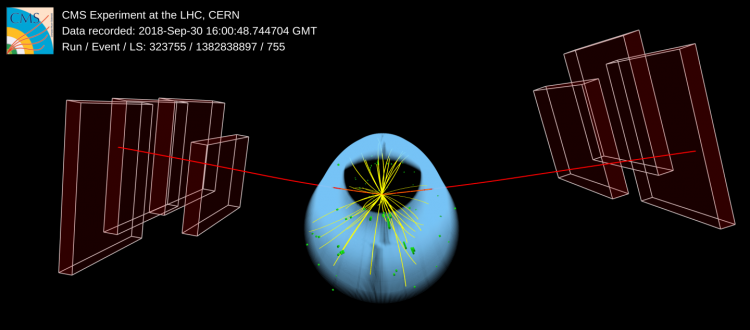
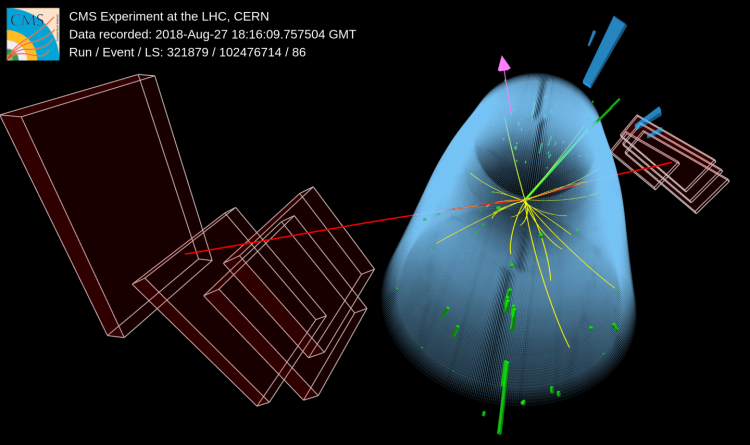
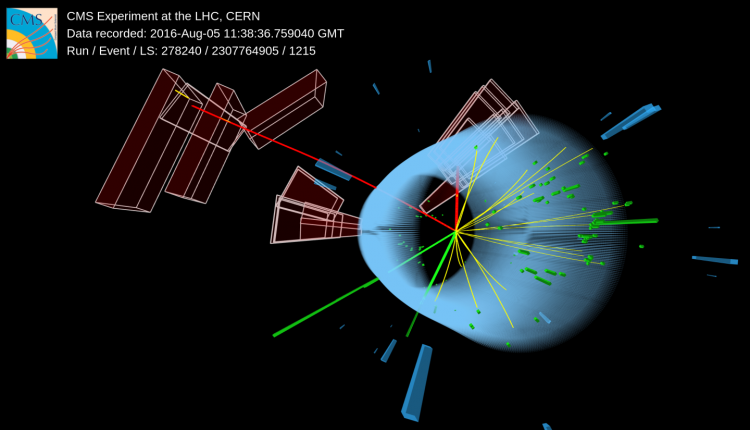
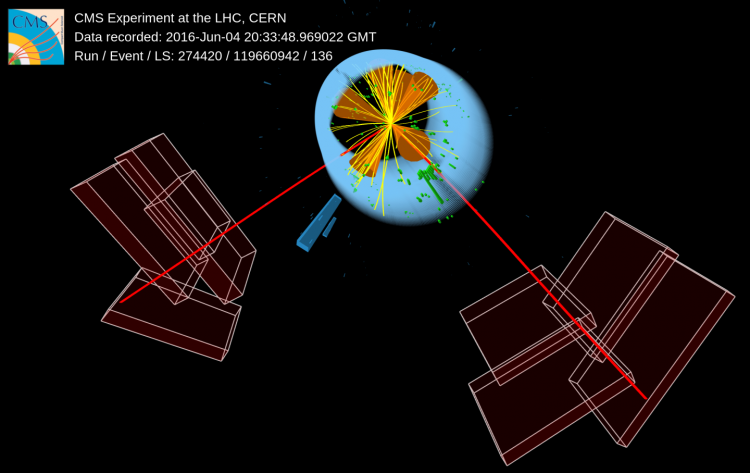


A new result released by the CMS Collaboration presents the first evidence of the Higgs boson interacting with the muon.
The standard model of particle physics describes all the known fundamental particles in the Universe. A mystery of the standard model is the vast spread of observed particle masses. The particles in the standard model have masses ranging from the very nearly massless neutrino to the top quark, with a mass several hundred thousand times heavier than that of the electron. The Higgs field, which plays a critical role in describing the particle masses, is postulated by the standard model to permeate all space. The strength of the interaction between the Higgs field and every particle then explains each particle's mass. While we know that the Higgs field gives particles mass, we do not understand why it gives different particles different mass.
To put it differently, why the Higgs field coupling strength is different for each particle is still a mystery and not explained by the standard model. This puzzle is particularly relevant as the electrons, quarks, neutrinos, etc., in the standard model can be ordered according to their mass into three groups, called generations. The reason why there are three generations is also not known. It is therefore vital to measure the difference between different generations and test if the standard model is indeed describing the way these particles behave.
The Higgs boson was famously discovered by the ATLAS and CMS Collaborations in 2012 and is the observed quantum particle associated with the Higgs field. Higgs bosons produced in LHC proton-proton collisions disintegrate (decay) nearly instantaneously to other fundamental particles. By measuring the Higgs boson decay rate to a particle, we can infer the interaction strength between the Higgs field and that particle. Therefore, these measurements directly test the predicted mechanism by which particles acquire mass. Since the Higgs boson discovery, there has been an enormous effort to understand how the Higgs boson couplings with the other fundamental particles compare with the precise predictions of the standard model. The measurements performed so far have focused on the Higgs boson interactions with the most massive particles, such as the W and Z bosons, and only with particles from the most massive generation, the top and bottom quark and the tau lepton. The interaction of the Higgs boson with the large span of lighter particles is so far experimentally untested. Measuring the full spread of Higgs boson interactions is a critical test necessary to understand whether the Higgs field can explain the full range of particle masses. Measuring the interaction of the Higgs boson with the muon, with a mass nearly two thousand times smaller than that of the top quark, is the next experimental frontier. Doing so will allow examining the Higgs field interactions with particles belonging to a different generation for the first time, and at a so-far untested mass scale.
The Higgs boson decay to muons is very rare, with only about one in five thousand Higgs bosons predicted to decay to muons. Adding to the challenge, for every predicted Higgs boson decay to muons at the LHC, there are about one thousand muon pairs that mimic every single Higgs boson. This background from other particles (like Z bosons) makes isolating the Higgs boson decay to muons at the LHC extremely difficult.
Besides its world-class muon detectors, the CMS detector uses a tracking system to measure the trajectories of charged particles with high precision. The tracking system measures muons as they pass through the very strong (3.8 Tesla) magnetic field, that is about 100000 times stronger than the earth's magnetic field. The CMS detector reconstructs a typical muon produced in an LHC collision within 1-2% of its true momentum and with very high efficiency. These extraordinary reconstruction capabilities have made it possible for the CMS Collaboration to report the first evidence for the Higgs field's meager interaction with muons.
The measurement sensitivity has been improved significantly compared to previous results. Four separate analyses were necessary to identify candidate signal events from the different modes by which Higgs bosons can be produced. The background prediction strategy includes sophisticated machine learning techniques like deep neural networks that help to differentiate the signal from the substantial background. The characteristic expected signature of the Higgs boson decay to muons is a small excess of events in the invariant mass of muon pairs near the Higgs boson mass of 125 GeV.
 Figure 1: The Higgs boson candidate invariant mass distribution for the weighted sum of all event categories. In the lower panel, which subtracts the predicted background from the data, an excess of events is observed in data that is consistent with the Higgs boson decaying to a pair of muons, indicated by the red line.
Figure 1: The Higgs boson candidate invariant mass distribution for the weighted sum of all event categories. In the lower panel, which subtracts the predicted background from the data, an excess of events is observed in data that is consistent with the Higgs boson decaying to a pair of muons, indicated by the red line.
Figure 1 shows the number of collisions for different values of the dimuon mass, where for each mass the number of collisions is counted. The Z boson background dominates and decreases going from smaller to larger masses. The tiny contribution of the Higgs boson decay to muons is invisible in the upper panel but indicated by the red line in the lower panel, which shows the distribution when the background is removed. An excess of events over the predicted background is visible in data, and the yield is consistent with the prediction for the Higgs boson decay to muons. Figure 2 displays the probability that the observed CMS data can be explained without there being a Higgs boson decaying to muons. If that probability is small this means the data is consistent with the signal. For a Higgs boson mass of 125.38 GeV, corresponding to the most precisely measured value to date, the probability that a statistical fluctuation can explain the observed signal is less than 1 in 700.
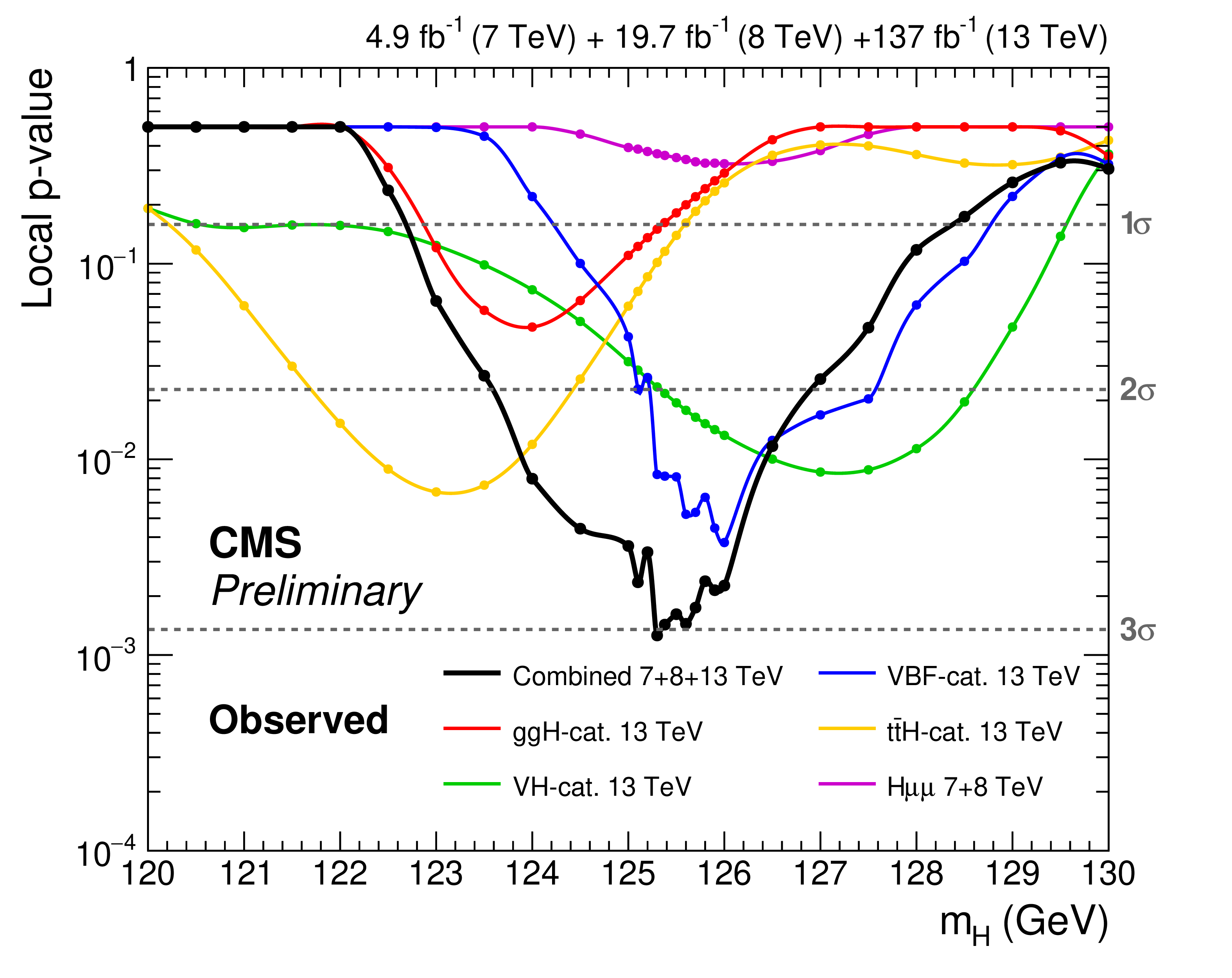 Figure 2: The consistency of the observed data with the absence of signal (p-value) as a function of the considered Higgs boson mass hypothesis. For a Higgs boson mass of 125.38 GeV, corresponding to the most precisely measured value to date, the probability that a statistical fluctuation can explain the observed signal is less than 1 in 700.
Figure 2: The consistency of the observed data with the absence of signal (p-value) as a function of the considered Higgs boson mass hypothesis. For a Higgs boson mass of 125.38 GeV, corresponding to the most precisely measured value to date, the probability that a statistical fluctuation can explain the observed signal is less than 1 in 700.
This result is the first measurement of the interaction between the Higgs boson and the muon, directly probing the Higgs boson coupling to the second generation of leptons. Figure 3 compares the latest CMS measurements of the Higgs boson interactions to the prediction by the standard model. With this new result, we can examine the Higgs field interaction with masses that are more than a factor 10 smaller than before.
 Figure 3: A summary of the CMS measurements of the Higgs boson couplings to the other fundamental particles, with the predictions by the standard model indicated by the dashed black line. In the lower panel, the ratio between the measured coupling and the standard model prediction is shown. This new CMS result presents the first measurement of the Higgs boson coupling to the muon, indicated by the left-most data point.
Figure 3: A summary of the CMS measurements of the Higgs boson couplings to the other fundamental particles, with the predictions by the standard model indicated by the dashed black line. In the lower panel, the ratio between the measured coupling and the standard model prediction is shown. This new CMS result presents the first measurement of the Higgs boson coupling to the muon, indicated by the left-most data point.
Although the muon measurement in Figure 3 is consistent with the blue line of the standard model, there are still substantial uncertainties. Because the Higgs boson decay to muons is so rare, the precision of this measurement is limited mainly by the amount of data collected so far. The quantity of accumulated data is expected to double from the upcoming Run-3 of the LHC, allowing for an improvement in the precision of this vital measurement in the next years. In the longer term, the unparalleled data quantities anticipated from the High-Luminosity LHC will enable the high-precision measurement of this interaction, one of the key milestones of the LHC physics program in the years to come.

